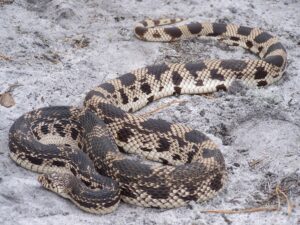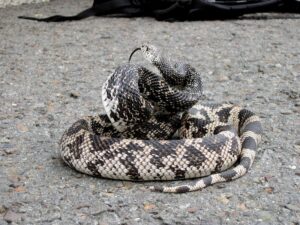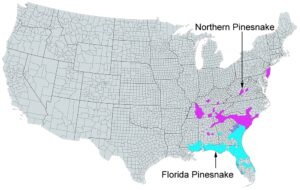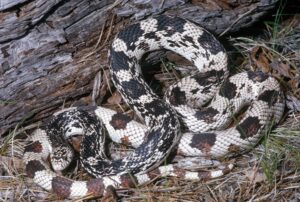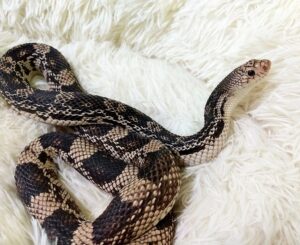Northern Pine Snake (Pituophis melanoleucus melanoleucus)
Updated on
25/04/2024The northern pine snake is a subspecies of the pine snake. It is a powerful, stout-bodied constrictor and one of the largest snakes of North America. It emerges from winter hibernation in late March or April and usually remains active till late October or November. But it may aestivate (enter dormancy similar to hibernation) during the summer. The diurnal snake spends most of its time underground, in burrows.
Scientific Classifications
- Suborder:Serpentes
- Family:Colubridae
- Genus:Pituophis
- Species:P. melanoleucus
- Subspecies:P. m. melanoleucus
Conservation Status
Description
Size
The average size of the colubrid is 48-66 in (122-168 cm). They can reach a maximum length of 72 in (180 cm).
Color and Appearance
The dorsal side of the body is white, cream, or yellow, with a series of irregular black blotches that are more prominent at the posterior side. The anterior pattern is more diffuse, with considerable dark coloration in the areas in between. The black lateral blotches alternate with the dorsal ones except on the tail. The belly is of a similar color but has no pattern. There can be a black crossbar mark connecting the eyes. The chin and labial scales are white, while the supralabials can be partially edged with black.
The snake has a distinct head that looks like a turtle’s due to its small size relative to the body and pointed snout. The snout together with the enlarged rostral scale, helps the pine snake dig efficiently. Unlike many North American snakes, it has four prefrontal scales that define its unique digging behavior.
Are They Dangerous to Humans
When confronted, the secretive snake tries to escape. When captured, it inflates its lungs and quickly releases air across a tissue flap on the glottis, creating a loud hissing sound. This is accompanied by tail vibration and striking. But having no venom, the snake is not dangerous to people.
Northern Pine Snakes at a Glance
Distribution
Its range includes southern North Carolina, southern New Jersey, extends west through South Carolina to northern Georgia, southeastern Kentucky, eastern Tennessee, and south into Alabama..
Habitat
The northern pine snake lives in dry upland forests, often with pine woods. It can also be found in dry, sandy coniferous forests. It needs forest openings with drained, sandy soils for basking and nesting. Summer nest sites are usually located in clearings near fallen logs. Winter hibernation sites are situated in nearby areas with leaf litter and more vegetation cover.
Lifespan
The serpent lives for 5-10 years.
Predators
They are eaten by raptors, red foxes, northern short-tailed shrews, and striped skunks.
Diet
It eats birds, bird eggs, rodents, and other small mammals. The young eat lizards, insects, and small mammals.
Reproduction
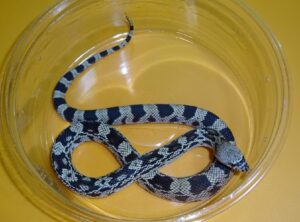
Oviparous (lays eggs that hatch outside the body)
Northern pinesnakes breed once a year from April to May, when the males engage in combat to display their dominance. The females lay clutches of about 8 large eggs in deep burrows dug in sandy soil. They hatch in mid-summer, with the hatchlings measuring 1.5 ft (30-45 cm). The juveniles are dull-colored until they shed, revealing brighter colors.
Care Sheet
Size of the Enclosure: An adult should be housed in a roomy enclosure of dimension 36” (length) x 18” (width) x 18” (height).
Temperature: The day temperature should be in the range of 78-90°F. The night temperature should be 70-75°F.
Humidity: They need a humidity level of 60-70%. A small water bowl can be provided for the pet to drink.
Substrate: Newspaper is excellent as the substrate. Pea gravel, wood shavings, pine needles, bracken, or heavy aquarium gravel can also be used.
Feeding: The adults should be fed a couple of mice once a week. Baby mice can be given to the hatchlings.
Source
pinelandsalliance.org, virginiaherpetologicalsociety.com, flickr.com, inaturalist.ca, strictlyreptiles.tv, reddit.com

